A remarkable set of ten glass lantern slides was listed for sale by a West Coast American vendor on eBay in 2010. Nothing is known of their history: Perhaps they were made by a music professor for his university lectures between the World Wars?
Each slide had been carefully prepared and numbered, so were obviously part of a much larger set. (It was only the early keyboard instruments which interested me, and which I purchased.) Each slide had been captioned with typewritten labels, most generically identifying the instrument type rather than being concerned with maker and provenance, but some providing memory snippets for the lecture presentation.
Not all captions were accurate: The “Piano by Silbermann” is actually a Mietke harpsichord, and it took some time to trace the “Piano-Maker, Antonio Colonna”. (New Grove lists a Fabio Colonna who invented an enharmonic harpsichord with eight keyboards, but Antonio Colonna was an organ maker.) Depictions of some of the instruments are interesting because they date from before modern restoration, and at least one instrument was lost in World War II.
The slides are reproduced below, along with a literal transcription of the labels. My ongoing task is to work through the images to positively identify each instrument pictured, noting its present whereabouts. As of September 2012, one square piano and one harpsichord remain.
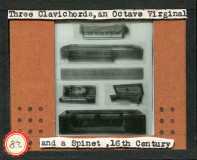 |

Slide 28
Three Clavichords, an Octave Virginal
and a Spinet, 16th Century
- Model of a clavichord, German C16th (Kunsthistorisches Museum, Wien)1
- Fretted clavichord by Dominicus Pisaurensis, Venice 1543 (Historische Musikinstrumenten-Museum der Karl Marx Universität, Leipzig)
- Closeup of nameboard inscription of above
- Fretted clavichord, German, mid C17th (ex-Leipzig, lost in the war)
- Virginal, Flemish 1568 (Victoria & Albert Museum, London)
- Spinet with clockwork drive, Samuel Bidermann, Augsburg early C17th (Wien)
|
|
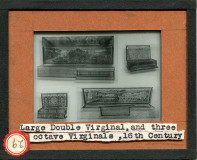 |

Slide 29
Large Double Virginal, and three
octave Virginals, 16th Century
- Mother & child virginals by Marten van der Biest, Antwerp 1580 (Germanisches Nationalmuseum, Nürnberg)
- Octave virginal, South German first half C17th (Leipzig)
- Octave virginal, Augsburg 1617 (Magyar Nemzeti Múzeum, Budapest)
- Flemish virginal, Joannes Grauwels, Antwerp c1580 (Musée des instruments de musique, Brussels)
|
|
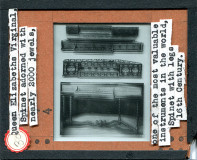 |

Slide 30
Queen Elizabeths Virginal,
Spinet adorned with
nearly 2000 jewels,
one of the most valuable
instruments in the world,
Spinet with legs
16th Century
- “Queen Elizabeth’s Virginals”, Italian c1570 (V&A)
- Virginal by Annibale dei Rossi, Milan 1577 (V&A)
- Virginal by Giovanni Antonio Baffo, Venice 1570 (Hotel de Cluny, Paris)
|
|
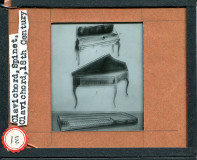 |

Slide 31
Clavichord, Spinet,
Clavichord, 18th Century
- Fretted clavichord by Christian Gottlob Hubert, Ansbach 1775 (Leipzig)
- Spinet by Johann Heinrich Silbermann, Strasbourg 1760/65 (Leipzig)
- Fretted clavichord by Johann Jacob Donat, Leipzig 1700 (Leipzig)
|
|
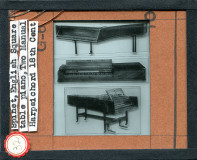 |

Slide 32
Spinet, English Square
table piano, Two Manual
Harpsichord 18th Cent
- Bentside spinet by Joseph Mahoon, London 1771 (V&A)
- †
- † Schudi?
|
|
 |

Slide 33
Two Harpsichords
- German Double-manual harpsichord, Harraß workshop, Thüringen c1700 (Musikinstrumenten-Museum, Berlin)
- Double-manual harpsichord by Andreas Ruckers the Elder 1631 (V&A)
|
|
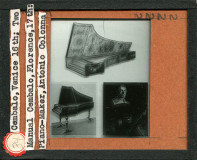 |

Slide 34
Cembalo, Venice 16th; Two
Manual Cembalo, Florence, 17th;
Piano-Maker, Antonio Colonna
- Italian harpsichord by Giovanni Antonio Baffo, Venice 1574 (V&A)
- German (?) double-manual harpsichord, 2nd half C17th–beginning C18th (Leipzig)
- “Ritratto dell‘organaro Antonio Colonna” by Giuliano Dinarelli c1614–1674, (Museo e
Biblioteca Internazionale della Musica, Bologna)2
|
|
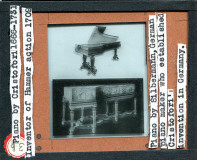 |

Slide 36
Piano by Cristofori 1666–1731
Inventor of Hammer action 1709
Piano by Silbermann, German
piano maker who established
Cristofori’s
invention in Germany.
- Pianoforte by Bartolomeo Cristofori, Padua 1726 (Leipzig)
- Single-manual harpsichord by Michael Mietke 1702–4 (Staatliche Schlösser und Museen, Berlin)
|
|
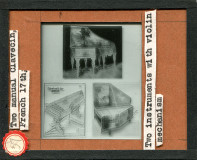 |

Slide 37
Two manual Clavecin,
French 17th;
Two instruments with violin
mechanism
- Double-manual harpsichord by Ioannes Ruckers, Antwerp 1628 (Château de Versailles)
- “Nürembergisch Geigenwerk”, Plate III woodcut from Michael Praetorius’ Theatrum instrumentorum, 1620
- Geigenwerk by Fray Raymundo Truchado, Spain 1625 (Brussels)
|
|
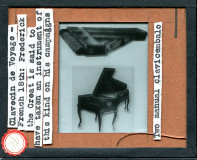 |

Slide 38
Clavecin de Voyage —
French 18th: Frederick
the Great is said to
have taken an instrument of
this kind on his campaigns
Two manual clavicembalo
- Clavecin brisé by Jean Marius, Paris 1713 (Leipzig)
- German double-manual harpsichord by Johann Heinrich Gräbner, Dresden 1774 (Leipzig)
|
|
| |
1 Advice of printed source gratefully received from John Koster: Schlosser, Julius; Die Sammlung Alter Musikinstrumente, Kunstverlag Anton Schroll & Co, Wein 1920.
2 Advice of printed source gratefully received from Patrizio Barbieri: Painting reproduced in color on cover of issue of “Recercare” Vol 21 No 1–2, 2009. |











